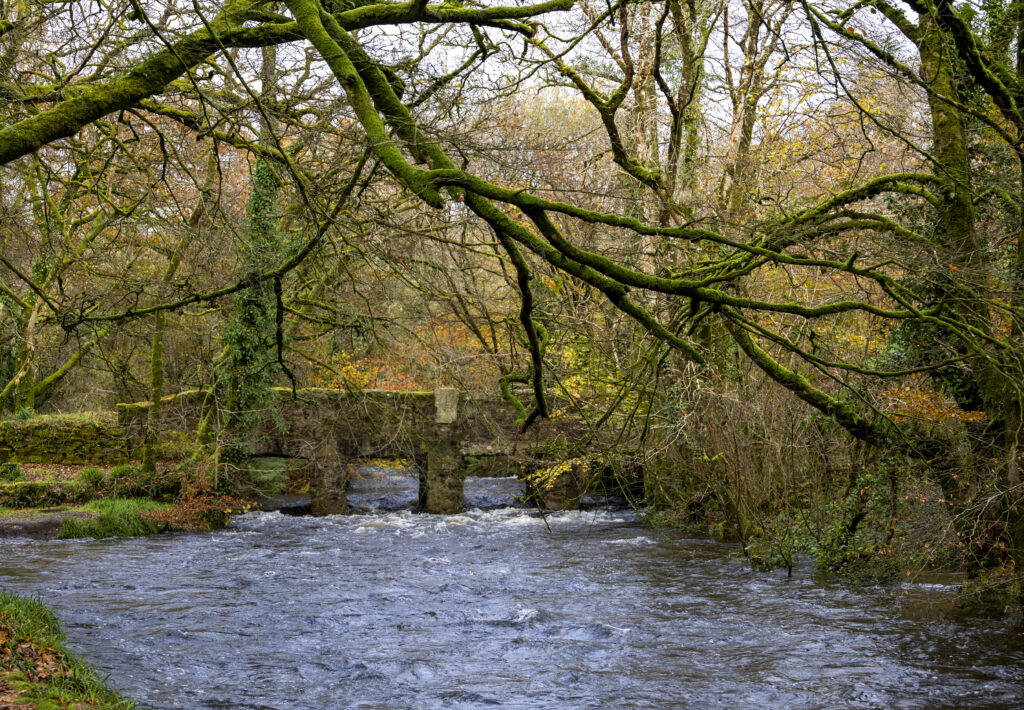The day dawned bright and hot – and just got hotter….
The kindness of Jamaica Inn management allowed “the adventurers” to gather alongside the “booters” of the regular car boot sale on Sunday 9th July, 1995. At the appointed starting hour, a leisurely 11.00am., 60 suitably kitted people gathered to be briefed on the requirements of the day and to meet the specialists who had kindly offered their services to interpret the landscape over which we were to travel:- Dr. Loveday Jenkin to identify flora and fauna, Peter Herring of the Cornwall Archaeological Unit and Dave Hooley of English Heritage to interpret the archaeology.
From, our entrance to the moor, got everyone into stride and at the gate the group had its first chance to hear the quality of our experts as Peter Herring unravelled the known history of Codda, one of the most important medieval dwellings on the moor. Then down the footpath and so to the first sight and crossing of the river – we were on the right track! So, over Scaddick Hill and along a hard, parched path to the open moor. That pathway was really disappointing all the dry weather had taken the fun from a usually boggy area where you have to work hard to keep dry feet! We rambled the open moor stopping to see turf rick steeds, lazy-beds and leats before reaching Leskernick Farm. This beautiful little farm and farmhouse was last occupied as a working farm some sixty-five years ago and gives a good idea of the isolation of moorland farming life before the days of the internal combustion engine. Following a leat allowed us to contour Leskernick Hill and to stay close to the Fowey.

Dave and Pete delivered an insight into tin-streaming, so evident in this area, and Loveday got her first chance to discuss the biological landscape. We were all getting very, very hot and there was a need to hide from the midday sun which was beating down unmercifully reminding everyone that these were the conditions Bronze Age people would have had on the moor perhaps they didn’t have it so good after all! Loveday then led most of the party into the rich flora regions which are the bogs of that area, whilst a few con-sidered survival a higher priority and headed onward…. With hope that the massive streaming works between Leskernick Hill and Buttern Hill might provide some shaded relief we pressed on. However, the height of the summer sun can cause problems and, as these workings were probably only worked in the winter, they had not been cut with shade in mind. We settled down for dinner and tried to forget that we were roasting hot and very sticky. To our relief, as dinner was drawing to a natural close the cooling east wind began to pick-up and some light cloud gradually removed some of the intensity of the direct sunlight. Some remained to rest whilst most continued a relatively short distance, over increasingly dry ground, to a point which we were sure was within a stone’s throw of the source. It was truly amazing that any water was left on the moors to create rivers after so much dry weather. Here Loveday expounded on the benefits of sphagnum moss and within five minutes had convinced us that were it not for this water stemming plant most of Bodmin Moor would have been in the river at Lostwithiel and beyond millions of years ago! Peter Herring never allows a walk to take place before he explains that archaeology is a never-ending seeking and that with open eyes, tuned to the ground, the day might produce some new find. It was on our return to the streaming works that Terry Harry from Cornwall Today magazine, one of the sponsors of this day made Peter’s prediction come true. Terry with his son Mark, in their efforts to obtain a modern communications signal to connect to base, found that Mark was standing on an unrecorded, unfinished granite millstone. Terry was covering the walk photographically so, 500 photographs later the party could at last proceed to have a short tour of Leskernick Hill and begin to see the magic of what is now being recognised as one of the most important prehistoric hills in Cornwall, possibly in Britain and maybe in Europe.
All too soon for most the day was drawing to a close and a return to modern civilisation was required. The day was, according to all, an immense success and there was a consistent request, as parting began, for – “more of the same please”.
CORNWALL HERITAGE TRUST, the organiser of the day, having been promised the continued help of members of Cornwall’s Outdoors (a business unit of Cornwall County Council advising on and a provider of education and adventure in the outdoors), of the experts who accompanied this trip and the sponsorship of CORNWALL TODAY magazine, will be offering a variety of activities for the public all of which will receive publicity in the magazine.
Cornwall Heritage Trust would like to thank all those who attended and provided invaluable donations to aid the restoration of Treffry viaduct, the helpers, the experts, Jamaica Inn for car parking facilities and Radio Cornwall for additional publicity before the event. Grateful thanks, also, to Cornwall Today magazine for their generous and continuing support during the 1990s.
If you would like to know more about Cornwall Heritage Trust and its programmes in 2020 then contact them on 01209 707008, they are now based at Krowji, West Park, Redruth TR15 3AJ see more at https://www.cornwallheritagetrust.org/
Terry Harry’s Note: Tony Blackman (now sadly deceased) whilst being an exceedingly wonderful fellow, he did tend to exaggerate, I only took 300 hundred photos on the day.
Thanks was given to Tony and I told him I was only joking. I also told him a million times not to exaggerate.